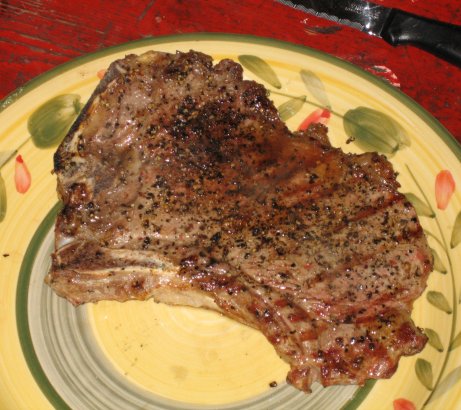
Very similar to this recipe
This recipe has four ingredients. A big porterhouse, cracked peppers, salt, and fire. This is manly steak grilling time, the opportunity to show off your grilling kung-fu. You just dropped a bundle on these steaks and they are now in your hands. Don’t mess up.
I find grilling steak a bit intimidating, I’m doing my very best to learn the vagueries of how different bits of cow react to fire but it’s a big job. I’ve been practicing the palm of the palm technique for judging doneness, and trying to get a sense of how hot a grill really is by holding my hand over it for X seconds. But all in all last summer was full of very mixed grilled steak results. The steaks I was sure were just shy of medium rare went all all the way from bloody to crispy. I don’t seem to have this problem in a pan, it’s just when I get outside. I suppose a lot has to do with hotspots and the weather outdoors, but I think the common factor is me. I’m pretty sure that my grilling chi is out of alignment.
I’m also a bit confused about steaks themselves. The recipe here calls for porterhouses. Turns out all porterhouses are T-bones, but not all T-bones are porterhouses. Apparently this has to do with the amount of tenderloin on the steak… who knew? Looking at the above picture I suppose I didn’t get a porterhouse, or a T-bone, at all. As far as I can tell I used striploin steaks. Which are T-bones, without the tenderloin attached. Confused? I sure am. To add a fun layer of complexity, in Quebec meat is billed using its French name, English translations are sometimes spotty and always metric. Remember that your 12 oz porterhouse is really a 340 gram chateaubriand.
In the end I got some very nice looking meat, that I salted, peppered and slapped on the grill. This was the first time I’d used this particular grill, and had no clue how it behaved. All in all I think I did OK. Goldilocks would have been proud, our three steaks were overdone, underdone, and just right.
The recipe (in the book, not the linked version) recommends searing the steaks for a couple minutes over very hight heat and then moving them to a cooler spot to finish cooking for ~15 minutes. They also recommend using a meat thermometer to check for doneness. This would have been a great idea if I’d had a meat thermomitor up on the island, and if my steaks hadn’t nearly finished cooking in the few minutes it took to sear them. The recipe does call for one and half inch steaks, mine were more like an inch thick, so this could explain the cooking times.
Overall everyone was delighted with their beef, I like mine on the rare side, and one of my dining companions prefers her steak grey. We all won. I think I butchered my adherence to the recipe pretty badly here, so I’m not sure I’m fit to comment on it. Pleasantly, summer is around the corner, and I’ll have ample opportunity to redo this. Yup, I’ll have to make a big succulent porterhouse in the name of science… life is hard.
a temporary rating of